The Crime of Punishment: At a TC forum, reflections on the impact of locking up young people
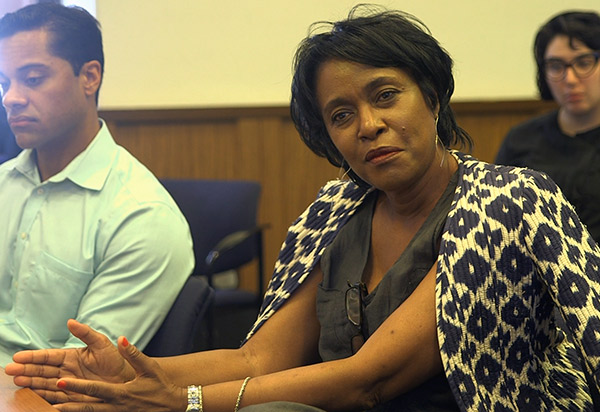
“Today I sentenced five young men, ages 14 to 15, who had committed some serious, gun-related offenses. With permission from the defense counsel, I spoke with one young man about personal things, like the fact that his best friend had been shot and killed. His father was there as well. So when I adjudicate to protect the community, that means not only protecting victims of gun violence, but also including the voices of people like this young man and his father, who also are victims.”
Edwina Richardson-Mendelson, Judge for the New York County Criminal Supreme Term and Bronx County Family Court, was addressing a rapt audience at “Youth and Wellbeing in an Age of Mass Incarceration,” a forum held in late August by Teachers College’s Civic Participation Project (CPP).
CPP was created by three TC professors – Yolanda Sealey-Ruiz, Laura Smith and Lalitha Vasudevan – to, in their words, “provide safe and brave spaces to discuss issues related to social justice and equity for young people in schools, address the palpable effects of social exclusion and the need for increased opportunities for democratic and civic participation” and “resonate with calls to action raised by the ‘Black Lives Matter’ movement.” But its broader agenda, said Sealey-Ruiz, Associate Professor of English Education, is “to disrupt the academy by opening up a space for people to be who they are and want to be, and to look each other in the eye and affirm one another’s humanity.”
"When I adjudicate to protect the community, that means not only protecting victims of gun violence, but also including the voices of people like this young man and his father, who also are victims.”
—Edwina Richardson-Mendelson, Judge for the New York County Criminal Supreme Term and Bronx County Family Court
An Acute Need
Along with Richardson-Mendelson, the forum brought together researchers, child welfare practitioners, educators, funders and others focused on improving the education and wellbeing of system-involved youth. The longterm goal is to formulate policy, research and practice-related recommendations.
The need is acute. The U.S. incarceration rate, which as of October 2013 stood at 716 per 100,000 of the national population, is the world’s highest. Among youth, the rate in 2010 was 225 per 100,000, with African-American youth nearly five times as likely to be confined as their white peers. Latino and American Indian youth are between two and three times as likely to be confined (the vast majority for nonviolent offenses).
“Youth incarceration has infused the practices of teaching, mental health and other fields,” said Vasudevan, Associate Professor of Technology & Education. “It has permeated societal practices and discourses. So we wanted people to have a conversation here that would cut across disciplinary boundaries.”
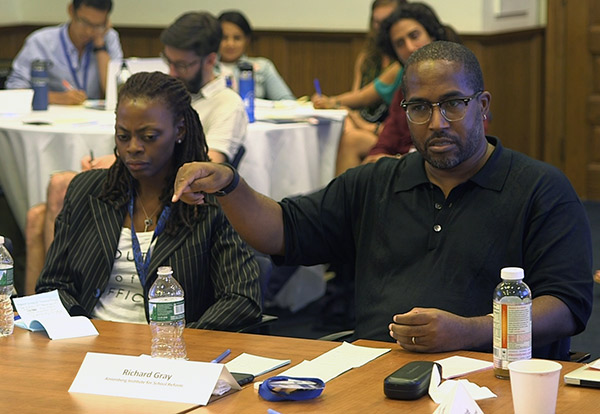
Nearly all the speakers concurred in framing incarceration as an issue of exclusion based on race and socio-economic status.
“All of the isms – racism, classism, sexism – operate to push some people out toward the margins of society while bringing others to the center,” said Smith, Associate Professor of Psychology & Education. “Those at the margins lack the best education, health care and jobs; a say in economic and political decisions, and a voice in the national discourse. They experience a silencing of their voices, the prevention of agency, exclusion from participatory democracy. How does all of that connect with youth wellbeing? You can’t be well if you’re excluded, if you spend your life in a social group that’s pressed up against the window, looking in. And who is more shut out than young people who have had control over their own bodies taken away – who are being adjudicated and incarcerated?”
A Seat at the Table
Others argued that among youth, all voices need to be heard.
“Youth incarceration has infused the practices of teaching, mental health and other fields. It has permeated societal practices and discourses." —Lalitha Vasudevan, Associate Professor of Technology & Education.
“It’s important to bring kids who have been marginalized to the table because it changes what we think about them,” said Melissa Wade, a Liaison with the New York Court Improvement Project who attended the forum in a private capacity. “When you listen to kids in foster care, you think, ‘These are young people who have agency.’ Misconceptions fall away and we can see what they need to succeed. So the old adage holds: ‘Nothing about us without us.’”
Vivian Gadsden, William T. Carter Professor of Child Development and Education at the University of Pennsylvania Graduate School of Education and current President of the American Educational Research Association (AERA), amplified that point, calling for the creation of “strategic alliances across the institutions and disciplines that serve and support youth,” particularly in education and public health. Through her founding and leadership of the National Center on Fathers and Families, Gadsden has worked extensively with families of incarcerated parents.
Other speakers emphasized the need for people to step out of their official roles in the system and behave more like human beings.
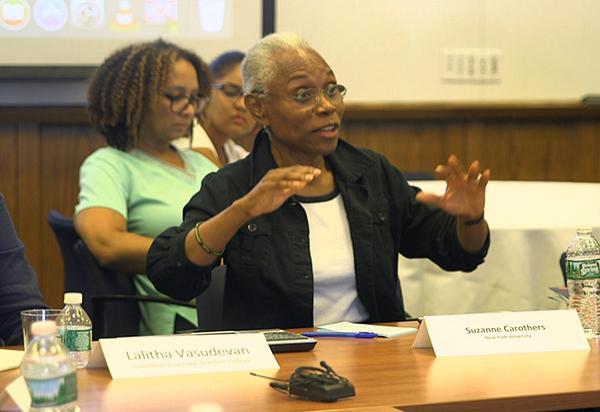
“Someone should show interest in a child before he or she is standing in front of a thoughtful judge,” said Suzanne Carothers, Professor of Early Childhood Education at NYU’s Steinhardt School of Culture, Education and Human Development. “We’ve got to provide opportunities for teachers to learn to notice what kids are feeling – to engage in problem-solving instead of just ‘fixing what is wrong.’ If a five-year-old says ‘I’m hungry’ and you say, ‘Sit and do your math,’ you’ve lost something.”
Carothers recounted a presentation she made at the annual AERA meeting, in which she asked people in the room to turn to one another and describe the qualities they’d seek in teachers and schools for their own children. Then she asked them whether, in doing research or making policy recommendations, they were applying that same standard.
"You can’t be well if you’re excluded, if you spend your life in a social group that’s pressed up against the window, looking in. And who is more shut out than young people who have had control over their own bodies taken away – who are being adjudicated and incarcerated?”
—Laura Smith, Associate Professor of Psychology & Education
“If it isn’t a good standard for my child, why on earth would I visit it on someone else’s?” Carothers demanded, adding that children’s needs vary. “In teacher education, if we were to do a more reflective process of understanding our practices as they related to children’s needs and family’s needs, we’d end up being much more inclusive of the richness that children bring into the room.”
Healing From Within
Still others argued that to help children, teachers and other caregivers need to deal with their own “brokenness” first.
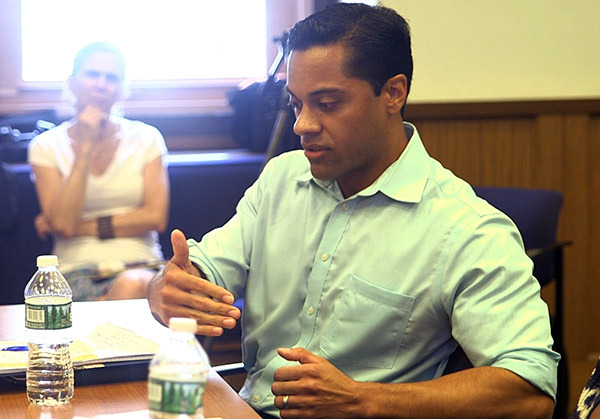
“I left front-line case work in Seattle after seeing a case where a bipolar mom had stabbed her two-year-old daughter 26 times,” said Antonio Garcia, Assistant Professor of Child Welfare and Co-Director of the Child Well-being and Child Welfare Specialization at the Penn School of Social Policy and Practice. “I thought, I don’t have the resources to prevent this from happening. That was my motivator to go to school – to change institutions to better support case workers.”
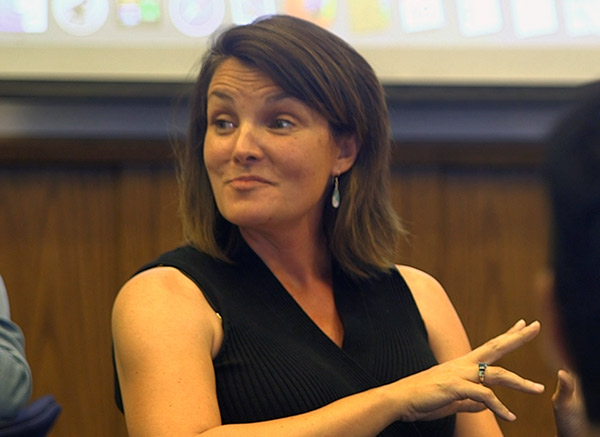
Often institutional bureaucracy is part of what cripples even the most idealistic caregivers. Marcelle Haddix, Dean’s Associate Professor and Chair of Reading and Language Arts at Syracuse University School of Education, described her travails in running an afterschool program based in a middle school that sometimes seemed openly hostile to the program’s existence.
“Our program met in the library, but the school kept the library locked,” she recounted. “Kids in detention were supposed to leave the building at the end of the day, so we had to sneak them into our program.”
Haddix’s recommendation: to involve parents whenever possible. “Schools do a good job of making sure parents and community members don’t know what’s going on,” she said, nevertheless adding that her own efforts to keep parents informed brought her smack up against another kind of institutional bureaucracy.
“I’m a professor, and that kind of work isn’t recognized in the academy,” she said.
The forum speakers also implicated themselves in some of the problems they were discussing.
“We come with good intentions, and the last thing we want to imagine is that we ourselves could do damage – but we can and probably will,” said Jess Dannhauser, President and CEO of Graham Windham, a family support and youth development organization in New York City and Westchester. “The temptation is to say to parents or others, ‘I wish everyone was as good to you as we are,’ but their experience of the system has to be validated, and you have to acknowledge that you’re a part of it.” – Joe Levine
The Forum marked the launch of CPP's Youth and Wellbeing Initiative, which will include open conversations, guest speakers, a podcast series, and related events throughout the year.
Published Tuesday, Aug 30, 2016